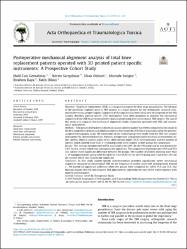| dc.contributor.author | Gemalmaz, Halil Can | |
| dc.contributor.author | Sarıyılmaz, Kerim | |
| dc.contributor.author | Özkunt, Okan | |
| dc.contributor.author | Sungur, Mustafa | |
| dc.contributor.author | Kaya, İbrahim | |
| dc.contributor.author | Dikici, Fatih | |
| dc.date.accessioned | 10.07.201910:49:13 | |
| dc.date.accessioned | 2019-07-10T19:37:32Z | |
| dc.date.available | 10.07.201910:49:14 | |
| dc.date.available | 2019-07-10T19:37:32Z | |
| dc.date.issued | 2019 | en_US |
| dc.identifier.citation | Gemalmaz, H. C., Sarıyılmaz, K., Özkunt, O., Sungur, M., Kaya, İ. ve Dikici, F. (2019). Postoperative mechanical alignment analysis of total knee replacement patients operated with 3d printed patient specific instruments: A prospective cohort study. Acta Orthopaedica et Traumatologica Turcica, 53(5), 323-328. https://dx.doi.org/10.1016/j.aott.2019.02.001 | en_US |
| dc.identifier.issn | 1017-995X | |
| dc.identifier.uri | https://hdl.handle.net/20.500.12511/1423 | |
| dc.identifier.uri | https://dx.doi.org/10.1016/j.aott.2019.02.001 | |
| dc.description.abstract | Objective: Total knee replacement (TKR) is a surgical treatment for final stage gonarthrosis. The lifespan of the prosthetic implants used in TKR surgery is a major interest for the orthopaedic research community.Previously, proper implant alignment of the implants has been advocated for longevity of the TKR surgery. Recently, patient-specific (PSI) instruments have been proposed to improve the mechanical alignment of the TKR by permitting better implant positioning over conventional TKR surgery. The aim of this study is to compare the mechanical alignment results of patients operated with PSIs and conventional instruments. Methods: Two groups of 20 patients chosen in a quasi-random manner have been compared in this study. In the first group femoral distal and tibial osteotomies were made by a PSI which was produced by the patients’ computed tomography scans. All osteotomies in the control group were made with the TKR set's routine instruments by conventional means. Patients’ preoperative and postoperative mechanical femorotibal angles (mFTA), femoral coronal angles (FCA), tibial coronal angles (TCA) were measured and the number of outliers which showed more than 3° of malalignment were counted in both groups for comparison. Results: The average postoperative mFTA was found to be 2.09° for the PSI group and in was found to be 284° for the control which was not statistically significant. The comparison of postoperative FCA and TCA also did not show significant difference between the groups. The number of outliers showing more than 3° of malalignment per group were found to be 1 out of 20 (5%) for the PSI group and 7 out of 20 (35%) for the control which was statistically significant. Conclusion: In this study patient-specific instrumentation provided significantly better mechanical alignment compared to conventional TKR for the frequency of outlier cases with malalignment beyond 3°. PSI proved no significant difference when the groups were compared for mFTA, FCA and TCA. Our findings support that PSI may improve TKR alignment by improving the ratio of the outlier patients with marked malalignment. Level of Evidence: Level III, Therapeutic Study. | en_US |
| dc.language.iso | eng | en_US |
| dc.publisher | Turkish Association of Orthopaedics and Traumatology | en_US |
| dc.rights | info:eu-repo/semantics/openAccess | en_US |
| dc.rights | Attribution-NonCommercial-NoDerivatives 4.0 International | * |
| dc.rights.uri | https://creativecommons.org/licenses/by-nc-nd/4.0/ | * |
| dc.subject | Mechanical Alignment | en_US |
| dc.subject | Patient Matched Instruments | en_US |
| dc.subject | Patient Specific Instruments | en_US |
| dc.subject | Total Knee Arthroplasty | en_US |
| dc.subject | Total Knee Replacement | en_US |
| dc.title | Postoperative mechanical alignment analysis of total knee replacement patients operated with 3d printed patient specific instruments: A prospective cohort study | en_US |
| dc.type | article | en_US |
| dc.relation.ispartof | Acta Orthopaedica et Traumatologica Turcica | en_US |
| dc.department | İstanbul Medipol Üniversitesi, Tıp Fakültesi, Cerrahi Tıp Bilimleri Bölümü, Ortopedi ve Travmatoloji Ana Bilim Dalı | en_US |
| dc.authorid | 0000-0002-6768-959X | en_US |
| dc.identifier.volume | 53 | en_US |
| dc.identifier.issue | 5 | en_US |
| dc.identifier.startpage | 323 | en_US |
| dc.identifier.endpage | 328 | en_US |
| dc.relation.publicationcategory | Makale - Uluslararası Hakemli Dergi - Kurum Öğretim Elemanı | en_US |
| dc.identifier.doi | 10.1016/j.aott.2019.02.001 | en_US |
| dc.identifier.wosquality | Q4 | en_US |
| dc.identifier.scopusquality | Q2 | en_US |



















